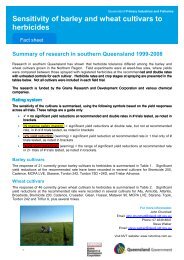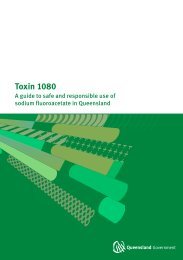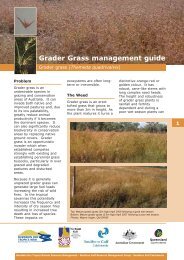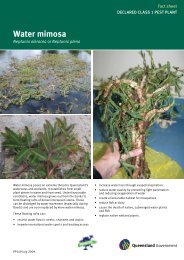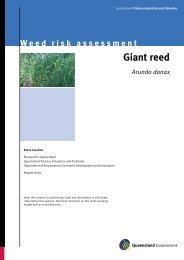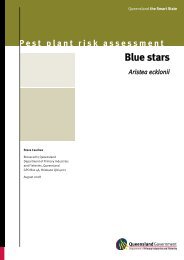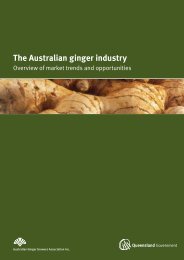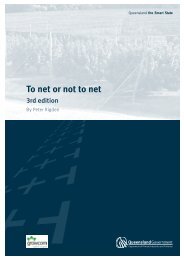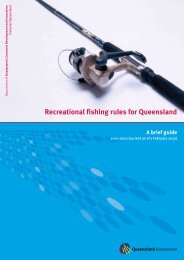Insect Control in Stored Grain - Department of Primary Industries
Insect Control in Stored Grain - Department of Primary Industries
Insect Control in Stored Grain - Department of Primary Industries
You also want an ePaper? Increase the reach of your titles
YUMPU automatically turns print PDFs into web optimized ePapers that Google loves.
Apply<strong>in</strong>g phosph<strong>in</strong>e<br />
Most gra<strong>in</strong> growers use phosph<strong>in</strong>e-generat<strong>in</strong>g tablets when fumigat<strong>in</strong>g. These tablets react with moisture <strong>in</strong><br />
the air to release phosph<strong>in</strong>e gas. Up to three days is needed to release all the gas, longer if the gra<strong>in</strong> is cool<br />
or very dry. The gas then moves through the gra<strong>in</strong>, usually with<strong>in</strong> a day <strong>in</strong> volumes up to a hundred tonnes.<br />
The problem <strong>of</strong> tablet residues <strong>in</strong> the gra<strong>in</strong> can be avoided by putt<strong>in</strong>g tablets on trays, suspend<strong>in</strong>g trays <strong>in</strong><br />
the head space or plac<strong>in</strong>g trays on the gra<strong>in</strong> surface. An alternative to us<strong>in</strong>g tablets is to use phosph<strong>in</strong>e<br />
products which are sold as bag cha<strong>in</strong>s, belts or blanket formulations. Do not place tablets <strong>in</strong> heaps on trays<br />
– as the tablets on the top smother the tablets underneath prevent<strong>in</strong>g full gas release.<br />
Warn<strong>in</strong>g: Do not add water to tablets. This causes a dangerous, quick release <strong>of</strong> gas which is less effective<br />
aga<strong>in</strong>st <strong>in</strong>sect pests.<br />
An ideal simple “tray” for phosph<strong>in</strong>e tablets <strong>in</strong> a<br />
small farm silo. Place tray <strong>in</strong> silo headspace,<br />
suspended or placed on gra<strong>in</strong> surface. Spent<br />
tablet residue doesn’t contam<strong>in</strong>ate gra<strong>in</strong> and is<br />
easily removed <strong>in</strong> the tray after fumigant has been<br />
vented from silo.<br />
Do not enter a fumigated storage to retrieve the spent fumigant formulation – phosph<strong>in</strong>e is toxic to humans.<br />
Once the full exposure period plus air<strong>in</strong>g period has passed, the spent formulation can be removed from<br />
outside the silo and buried. Some phosph<strong>in</strong>e will be given <strong>of</strong>f by the spent formulation dust, so do not carry<br />
it <strong>in</strong> a conf<strong>in</strong>ed space.<br />
The SIROFLO® system for apply<strong>in</strong>g phosph<strong>in</strong>e as a gas<br />
The SIROFLO ® application system cont<strong>in</strong>ually <strong>in</strong>troduces a low concentration <strong>of</strong> phosphor\<strong>in</strong>e <strong>in</strong>to a silo<br />
from a cyl<strong>in</strong>der for 21 days plus. The gas flows through the silo and out, usually at the top <strong>of</strong> the silo.<br />
Orig<strong>in</strong>ally developed for very large silos, SIROFLO® is now available for small-scale storages. The<br />
advantage <strong>of</strong> this method is that the silo does not have to be sealed to the high standard required for<br />
conventional fumigation.<br />
Although much more expensive than us<strong>in</strong>g tablets, it has application <strong>in</strong> specific bulk storage systems. The<br />
system us<strong>in</strong>g the product named Eco2Fume ® is available through Cytec Australia Hold<strong>in</strong>gs, Baulkham<br />
Hills, NSW, Ph: 02 98 466 200, website :www.cytec.com.au/<br />
Dose rate and fumigation times for solid formulations <strong>of</strong> phosph<strong>in</strong>e<br />
Effective fumigation <strong>of</strong> gra<strong>in</strong> needs 1.5 tablets per cubic metre <strong>of</strong> total storage capacity (i.e, not the<br />
tonnage <strong>of</strong> gra<strong>in</strong> actually <strong>in</strong> the storage).<br />
A tablet releases 1 gram <strong>of</strong> phosph<strong>in</strong>e, so 1.5 tablets per cubic metre is equivalent to 1.5 grams per cubic<br />
metre.<br />
Examples <strong>of</strong> application rates <strong>of</strong> tablets for storages <strong>of</strong> various sizes are shown <strong>in</strong> Table 8 below.<br />
Phosph<strong>in</strong>e moves through the whole air space, so apply the same number <strong>of</strong> tablets whether the storage is<br />
full or partly full with gra<strong>in</strong><br />
12





